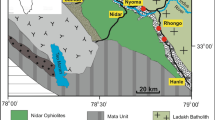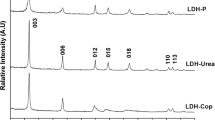Abstract
It is assumed that clay soil with high Fe contents as its main ingredient was used in the red pigment layers on the surfaces of the Neolithic Age Red Painted pottery and the Red Burnished pottery in the Bronze Age that were excavated from the southern areas of the Korean peninsula. A variety of phases of iron oxides that form pigment layers were identified through X-ray diffraction analysis, Raman spectroscopy and Mössbauer spectroscopy in this study. In particular, although previous studies focused only on hematite as a pigment mineral, the Mössbauer spectra of pigment layers in this study showed a higher spectrum area ratio of sextet by ferrihydrite than that by hematite, implying that ferrihydrite in reddish-brown might have played a significant role in developing its color. In addition, as it can be seen in each specimen showing a different area ratio by site in the Mössbauer spectrum, compositions of Fe-containing minerals were different. It is assumed to have been caused by different ionic forms of iron in the soil materials and unstable firing atmosphere during Pit firing.








Similar content being viewed by others
References
Song YJ (2016) A study on the burnished pottery of Bronze Age Korea Peninsula. Dept. of History, Doctoral thesis, Graduate School of Gyeongsang National University, Jinju (in Korean with English abstract)
Nam SW (2013) As production technology, the meaning of the Black burnished pottery in Baekje Dynasty. J Korean Archaeol Soc 89:94–137 (in Korean with English abstract)
Cho HJ, Yang SR (1988) Pottery analysis of Songguk-ri site, Sinam-ri I. Natl Mus Hist Sites Res Rep 20:118–119 (in Korean)
Han JU (2010) Study on the material characteristics of the red burnished potteries from gangwon region, Korea: focusing on Osan-ri in Yangyang, Daedae-ri in Goseong, Jucheon-ri on Yeongwol. Master’s thesis, Dept. of Cultural Heritage Conservation Science, Graduate School of Kong Ju National University, Gonju (in Korean with English abstract)
Bouchez R, Coey J, Coussement R, Schmidt K, van Rossum M, Aprahamian J, Deshayes J (1974) Mössbauer study of firing conditions used in the manufacture of the grey and red ware of Tureng-Tepe. J Phys Colloq 35(C6):541–546. https://doi.org/10.1051/jphyscol:19746115
Kostikas A, Simopoulos A (1974) Mössbauer studies of ancient pottery. J Phys Colloq 35(C1):107–115. https://doi.org/10.1051/jphyscol:1974133
Maggetti M (1982) Phase Analysis and Its Significance for Technology and Origin. Archaeological Ceramics, Smithsonian Institution Press, Washington, D.C.
Venkatachalapathy R, Gournis D, Manoharan C, Dhanapandian S, Deenadayalan K (2003) Application of FTIR and Mössbauer spectroscopy in analysis of some South Indian archaeological potteries. Indian J Pure Appl Phys 41:833–838
Amzal M, Bouhas A, Benchaba H (1996) Mössbauer studies of Algerian ancient pottery. J Radioanal Nucl Chem 213:193–198. https://doi.org/10.1007/BF02165690
Nagy S, Kuzmann E, Weiszburg T, Gyökeres-Tóth M, Riedel M (2000) Oxide transformation during preparation of black pottery in Hungary. J Radioanal Nucl Chem 246:91–96. https://doi.org/10.1023/A:1006733131174
Hanesch M (2009) Raman spectroscopy of iron oxides and oxy(hydroxides) at lower laser power and possible application in environmental magnetic studies. Geophys J Int 177:941–948. https://doi.org/10.1111/j.1365-246X.2009.04122.x
Cornell RM, Schwertmann U (2003) The Iron Oxides: Structure, Properties, Reactions, Occurrences and Uses. Wiley-VCH, Weinheim
Byrne J, Kappler A (2019) Mössbauer spectroscopy, analytical geomicrobiology: a handbook of instrumental techniques. Cambridge University Press, Cambridge
Cudennec Y, Lecerf A (2005) Topotactic transformations of goethite and lepidocrocite into hematite and maghemite. Solid State Sci 7:520–529. https://doi.org/10.1016/j.solidstatesciences.2005.02.002
Fang J, Kumbar A, Zhou WL, Stokes KL (2003) Nanoneedles of maghemite iron oxide prepared from a wet chemical route. Mater Res Bull 38:461–467. https://doi.org/10.1016/S0025-5408(02)01066-8
Gorski CA, Scherer MM (2010) Determination of nanoparticulate magnetite stoichiometry by Mössbauer spectroscopy, acidic dissolution, and powder X-ray diffraction: A critical review. Am Mineral 95:1017–1026. https://doi.org/10.2138/am.2010.3435
Jeon AY, No HG, Kim US, Cho WS, Kim KJ, Kim JY, Kim CM, Kim CS, Kang KI (2012) Systematic study on colorative mechanism of ancient goryeo celadon glaze by mossbauer spectroscopy and chromaticity analysis J Korean Ceram Soc 49:66–71. https://doi.org/10.4191/kcers.2012.49.1.066(in Korean with English abstract)
Acknowledgements
The samples used in this study were provided by the Jinju National Museum in Korea, and we are grateful for this.
Author information
Authors and Affiliations
Corresponding author
Additional information
Publisher's Note
Springer Nature remains neutral with regard to jurisdictional claims in published maps and institutional affiliations.
Rights and permissions
About this article
Cite this article
Lee, M.H., Han, M.S., Uhm, Y.R. et al. Phase analysis of iron oxides forming the red pigment layer of the ancient earthenwares excavated from the southern Korean Peninsula. J Radioanal Nucl Chem 330, 529–538 (2021). https://doi.org/10.1007/s10967-021-07866-x
Received:
Accepted:
Published:
Issue Date:
DOI: https://doi.org/10.1007/s10967-021-07866-x




